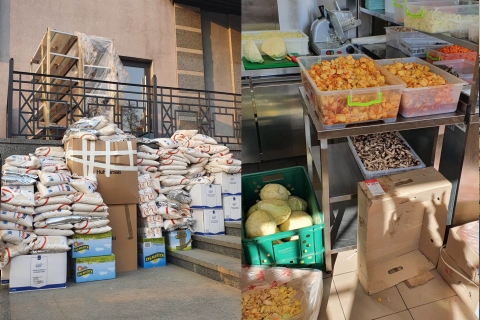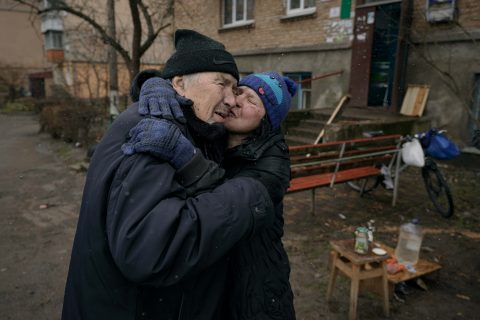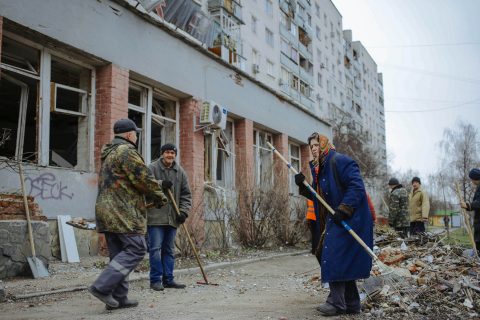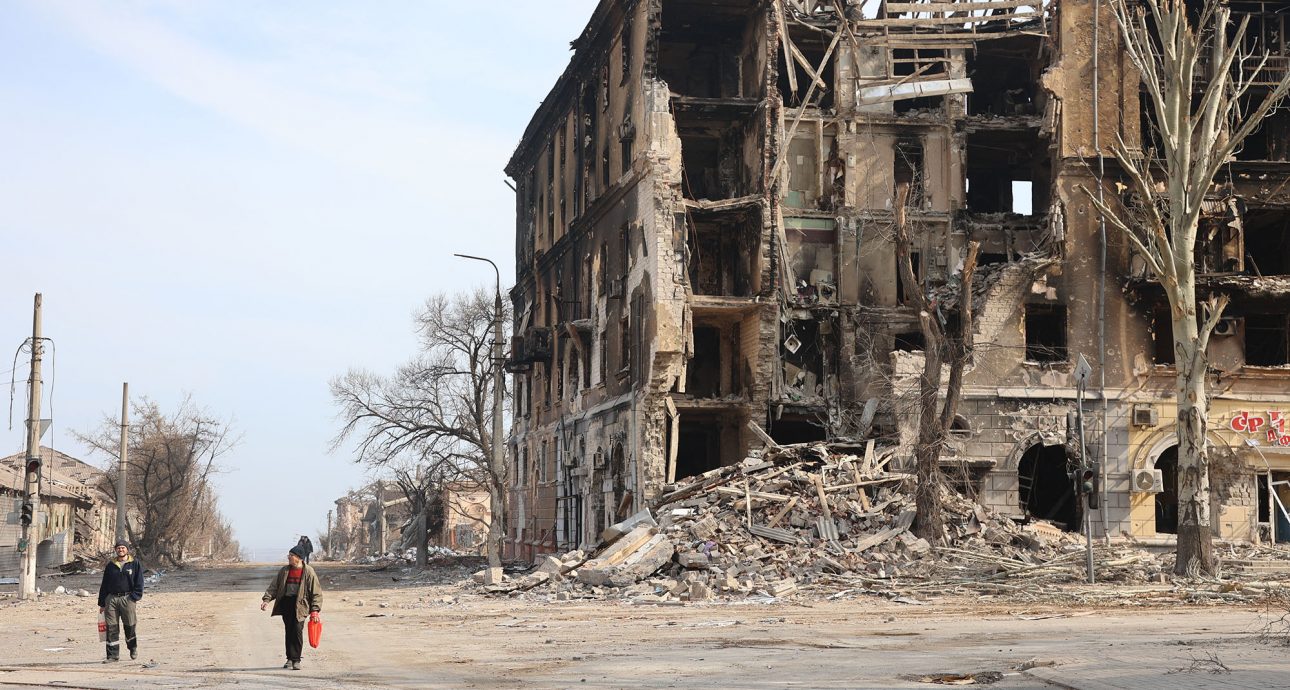
“After Their First Round Trip, Some Go on a Drinking Bout to Recoup from What They’ve Been through”: a Volunteer on Evacuating Mariupol Residents
Battles for Mariupol have been raging on since the very beginning of Russia’s full-on invasion of Ukraine, with almost all of the city currently lying in ruins. Despite the destruction and hostilities, several dozen thousand civilians have lived there for over a month, without any means of communication, running water or food. The Ukrainian government’s attempts to evacuate them have failed — the Russians refuse to agree on the relief corridors for evacuation. Therefore, its volunteers who have been getting locals out of the city.
In mid-March, TV presenter and Mariupol native Denys Minin decided to help with the evacuation. He set up an informal organization to bring together volunteers and drivers willing to go to Mariupol. Minin took on the team coordination responsibilities and kept doing his job even after all journalists and most medics had left. A few hundred civilians have already fled the ruined Mariupol owing to his work.
Bird in Flight talked to Denys Minin to find out how drivers get into the besieged city, why volunteers are frowned upon at checkpoints, and what the lives of the people heading to Mariupol depend on.

A TV presenter before the war, currently a volunteer
I’d like to start with the question that has been bugging me for a while. What does it take to get to Mariupol now?
A week ago, our drivers managed to take minibuses there. Granted, they had to take the roads less travelled, coming up with new routes every time. Also, they don’t rely on clear-cut algorithms because the military environment and the situation at checkpoints are in constant flux. For instance, now we see militiamen from the so-called DPR at the checkpoints where the Russians were until recently.
There’s no way of getting minibuses into Mariupol now. However, there are other ways to enter the city — I will not disclose them until after the war, though.
What do the drivers say about the city? What does it look like?
Today, Mariupol is an ugly sight. Everything is destroyed, and people’s limbs lay on the roads here and there. You can’t get used to seeing that.
When and how did you get involved in evacuating Mariupol residents?
When the war began, my parents refused to leave the city, though I tried to persuade them to every day. Then, the frequency of shelling increased, and cell service went down. It became evident that Mariupol was just getting wiped out. I had to evacuate my parents.
With this in mind, I approached volunteers. I filled out some paperwork and was added to a long list. In a few days, I realized that I didn’t have that much time to wait and decided to take the situation into my own hands. So, I started to look for transport. People refused to lend me their cars, realizing they might never see them again.
Roughly at that time, I got to know the volunteers evacuating locals better. They revealed to me the specifics of the evacuation route. A lot of details had to be taken into account.
Today, Mariupol is an ugly sight. Everything is destroyed, and people’s limbs lay on the roads here and there.
Having talked to the volunteers, I realized there were two ways of getting people out of Mariupol: by cars and by minibuses. Big buses were out of the question: the Russians didn’t want many people getting to the Ukrainian side at once.
As it turned out, hundreds of people drove to the city in their own cars, bringing humanitarian aid and evacuating their friends, family, and others on their way back. However, they didn’t know any routes, nor the algorithms for interactions at checkpoints, much less what awaited them on their way. Therefore, I decided to introduce the people willing to do it to volunteers. The drivers gathered in Zaporizhzhia. I posted the information about it on Instagram. Later, I created the From Mariupol to Zaporizhzhia channel on Telegram — it now has 7,000 followers. I am glad that it works without my intervention: people just gather at the given time at the agreed place, and my colleagues instruct them.
Then I turned my attention to the other aspect of these activities — getting people out by minibuses. This is what I do now. Some of them go to Berdiansk, others to Mariupol.
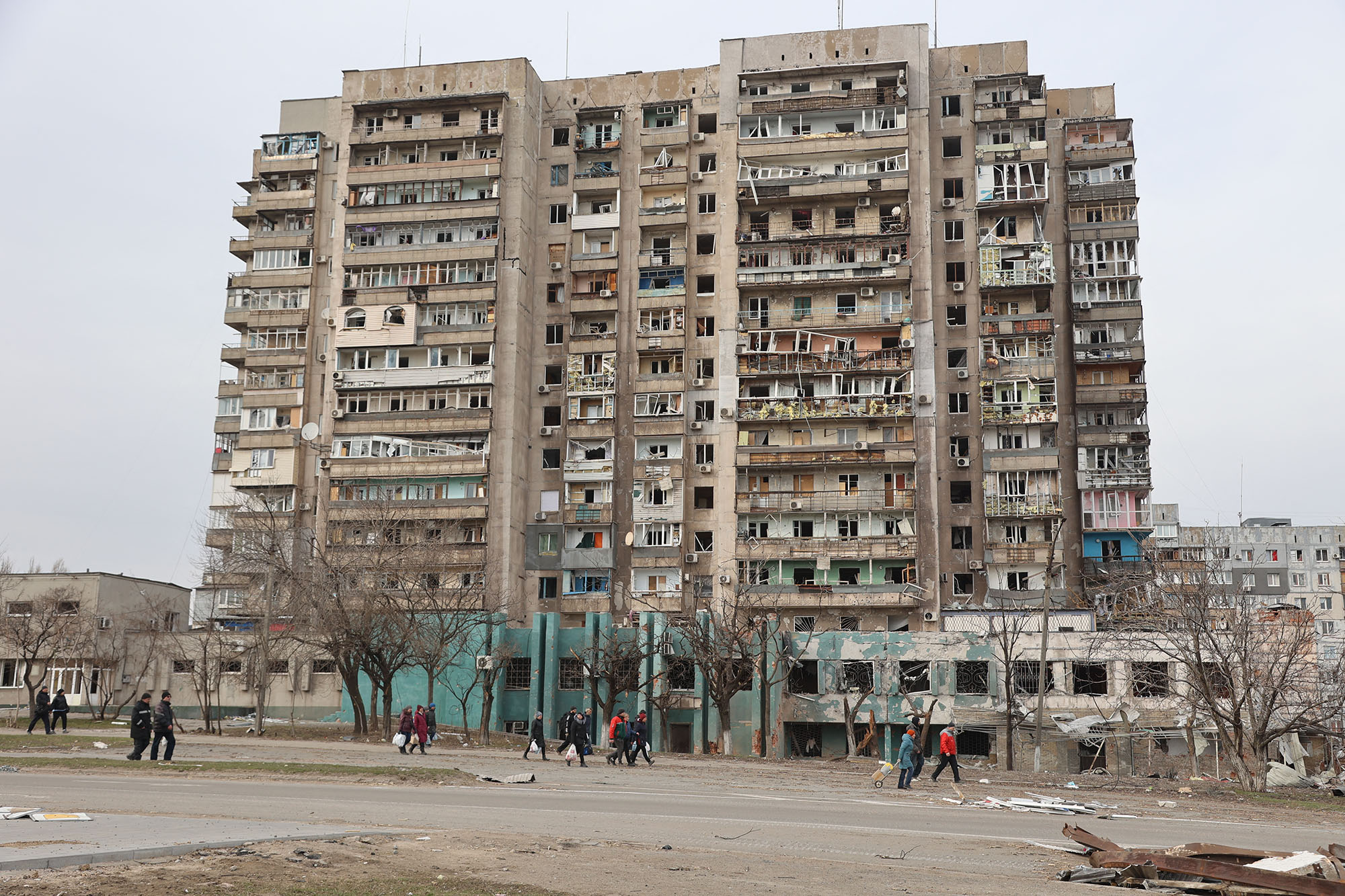
The buildings destroyed by shelling in Mariupol (the 29th of March 2022). Photo: Leon Klein / AFP
How many people are there on your team?
The team’s core is eight volunteers. Others come and go, contributing to the common cause in any way they can. Besides, we have twenty minibuses and six cars that accompany the buses in Mariupol. They take humanitarian consignments there and pick up people on their way back. Another three drivers were captured with their minibuses — I’m making every effort to get them out. The drivers are peaceful people. They did nothing wrong, just started evacuating people from Mariupol a month ago.
How many drivers do you have?
After their first round trip, some go on a drinking bout to recoup from what they’ve been through. Others can endure up to five or six trips. It’s hard to count them.
Do the drivers realize they can die there?
They sure do. My team has suffered no losses so far, but the one I know has. They lost a young guy — he was experienced enough to pass checkpoints without a hitch, but something went wrong. He didn’t get in touch for seven days after he left. Later, someone saw a picture of his minibus riddled with bullets somewhere on Telegram. There was blood on the driver’s seat.
Therefore, our drivers are always tense. It’s hard to go when you know that the people around you feel they have the right to take your life. Also, they would almost certainly drive under heavy shelling — it’s a usual thing. No wonder some people say they won’t go there again after their first trip. However, others keep hurrying back because people are waiting for them.
Why do the drivers agree to go there, even though they know they might not return?
Some want to get their family out. We give them a vehicle and fuel in exchange for them picking up a few other people. Sometimes, people get all their close ones from Mariupol in one trip. Other times they don’t and keep returning until everyone is out.
Another category is those who want to help. These are simple men — former workers at metallurgical plants, including those in Mariupol. Probably, we wouldn’t have met otherwise, but now we have a common cause — rescuing people from the city. One of the drivers even did his time in prison for stealing cars, among other things. He is in his fifties and previously had drug problems. He says he wants to redeem himself by helping others. He has brought over fifty people from Berdiansk already.
One of the drivers even did his time in prison. He wants to redeem himself by helping others.
In general, looking for drivers takes a lot of time. My colleagues interview every candidate. We must know if the person can handle all they will see in Mariupol. We have turned down a few and put those whom we had doubts about on the Berdiansk route to give them a taste of what might await in Mariupol.
I feel that preparations for such a trip should take at least as much time as a one-way trip. What do they include?
I could write a book about it, but I’ll try to be brief.
Most of our fleet are Mercedes-Benz Sprinter minibuses manufactured in the end-1990s. There were used as shuttle vans before the war. The vehicles undergo technical check-ups first thing before the trip. Then they are loaded with humanitarian aid: food, water, and medications. Then it’s the paperwork’s turn. I can’t disclose which documents we prepare, though.
Meanwhile, we brief drivers. As the most recent precaution, we forbid them to say they are volunteers at checkpoints. It’s a huge red flag for the DPR militia — they can’t wrap their minds around why would someone do anything for free. We are now inventing a cover for every driver, so they can explain who they are, why they are going to Mariupol, and where they bought the vehicle and for what money. Every detail counts because any inconsistency might cost them not just their wheels but their lives. Then we explain the route.
Any inconsistency may cost them not just their wheels but their lives.
Also, we buy disposable razors, toothbrushes, tea, sunflower seeds, cigarettes, and SIM starter kits. Enemy soldiers are interested in these, which may make passing checkpoints easier.
From the preparations to the return trip, it takes four to five days. Sending one minibus, we start preparing another. Rinse and repeat. Preparing a driver, we worry about the one on a trip. If a driver doesn’t return in time, we become restless.
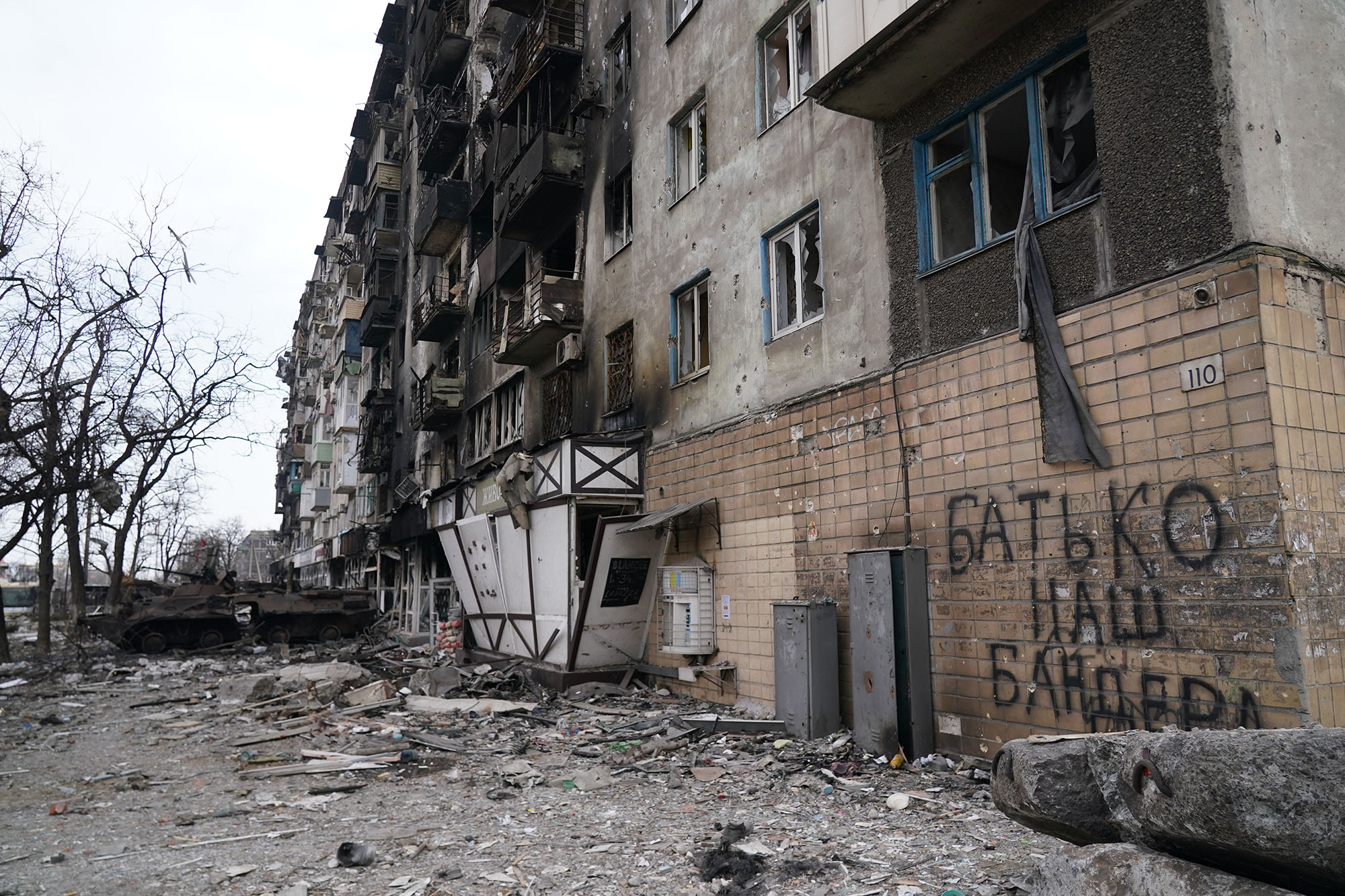
A building destroyed by shelling in Mariupol (the 26th of March 2022). Photo: Stringer / AFP
You said that the Russian checkpoints are now manned by the soldiers of the so-called DPR. Who is easier to deal with?
They deserve each other. As the saying goes, “There is no worse enemy than a former friend”. And it holds true in this case. The DPR soldiers are suspicious of everyone coming from Ukraine. They believe that only “traitors” and Ukrainian army conspirators can come from here. They are more aggressive, too. And overall, the closer you are to the city, the higher your chances of ending up in prison. There is no law there. All you can do is persuade the soldier while talking to them.
If you managed to organize the evacuation, why can’t we agree on relief corridors?
It’s a question for the negotiators. At the very beginning of the war, I heard about the relief corridors through which 2,500 people evacuated. But what is a relief corridor? You don’t need to stop when you use it. And it’s not a relief corridor, where there are 20 checkpoints and soldiers want to relieve you even of your boots at each. No wonder the people who left Mariupol heard nothing of them.
But I don’t blame our government. After all, the occupiers themselves don’t want people to get evacuated to the Ukrainian territory. Moreover, there is nobody with whom you can negotiate the evacuation anyway. And they do everything they can to prevent it.
Recently, I have talked to my friend who left Mariupol for Novoazovsk. He was told that men were conscripted right at the Ukrainian checkpoints, that Zaporizhzhia was under siege, and that Ukraine was in ruins. This is how they brainwash the Mariupol residents. There is no way to fact-check the information there — the cell service is down in the city. And when you are told these horrific stories time and time again to the sounds of shelling outdoors, you kinda start believing in them.
After all, the occupiers themselves don’t want people to get evacuated to the Ukrainian territory
On your social media, you warn people against dealing with scammers. Is there a lot of these?
There was a lot, but they are fewer now. A person would say they were a driver, send you a photo of a vehicle, take pre-payment and money for fuel or whatever, and then dispose of the SIM card. A classic Viber scam, which earned people a lot of money at others’ expense. Judging by what the victims said, it’s mostly former convicts who did that.
Therefore, I have always said that if you negotiate a paid evacuation, you pay the driver once they get you out. Paying upfront is a big no-no. Also, you need to bear in mind that volunteers don’t ask for money. We say, if you feel compelled to help our mission, you can do it, but it’s not mandatory.
Where do you get many to buy fuel?
We get them from donations. We pay with them for fuel and technical check-ups. I can even give some money to drivers as a thank you. I deliberately don’t call it a payment because it’s not the money that our drivers are working for. I do understand, though, that they need to provide for their families.
What does your volunteer movement currently need?
We have recently started buying cars. We need them — the more, the better.
What are the requirements for cars?
None whatsoever. We even put a Zhiguli car on one of our routes once we had put it into shape. One guy donated his Suzuki Grand Vitara. Just like that — a complete stranger came, left his keys and the car, and left. No questions asked. If you want to help, you just do it.
How many people have you evacuated so far?
I don’t have precise figures, but I believe over a thousand.
Cover Photo: Leon Klein / AFP
New and best
